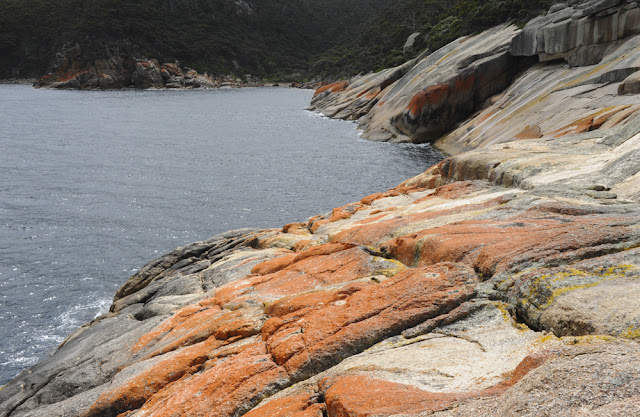It's still hot in Canberra and there are a great number of butterflies about, although apart from the occasional flutter-by their abundance is not obvious. Those in the forest are keeping low and in shade for much of the day, like this Common Brown Heteronympha merope which, typical of its species, was sitting hidden on the forest floor litter with its wings closed, only flying when disturbed by my footfall close by. Then about a dozen others erupted from the litter. They should have stayed where they were as I wasn't about to trample them and I certainly had not seen them.
Many other Common Browns were hanging from the drooping branches and leaves of the trees, or on the trunks, wherever there was shade from the intense sunshine. This one has a very abraded wing and the pattern of the other upper forewing can be partially seen, enough to recognise it as a female by the large blotchy markings.
In amongst the Common Browns were several Marbled Xenicas Geitoneura klugii which closed their wings as soon as they landed on the litter and simply disappeared from my vision. I clould only grab this one shot through the grases as one landed and immediately closed its wings.
Then in a sunny open glade where there was a patch of heath and low-growing herbs I saw a few of these delicate little Blotched Dusky-blues Candalides acasta. The blotch refers to the large smudged dark grey spot on the edge of the hindwing.
This was as wide as this butterfly held its wings open. A pity as the soft blue on the upper wings has an elegant tone.
I watched a group of Stencilled Hairstreaks Jalmanus ictinus chasing one another and laying eggs on a wattle tree, but they were to high to photograph. However, I did take some shots of this Imperial Hairstreak J. evagoras as it perched on smaller wattle bush.
The back edge of this species' hind wing is coloured and curled in a curious way. And the butterfly was moving each hindwing slowly and asynchronously as if to imitate another animal, or to give the impression that its head was at that end if any potential predator was nearby. When seen from above, the modified wings have a three-dimensional appearance, adding further to the impression of perhaps a head on an otherwise slim body.
The wavy edge to the hind wings seen from below.
Occasionally, the butterfly opened its wings to reveal a shimmering coat of scales. And when it flew, as when I first saw it and probably the only reason I spotted it, it was a blue light shining in the shade of the forest.






















































